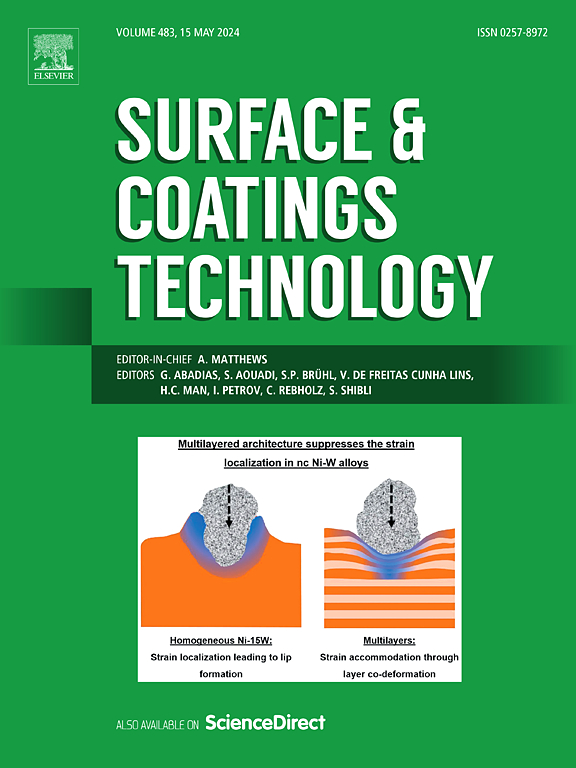PDMS@SiO2表面改性超疏水三聚氰胺海绵增强减阻
IF 5.3
2区 材料科学
Q1 MATERIALS SCIENCE, COATINGS & FILMS
引用次数: 0
摘要
作为海洋工程不可或缺的一部分,海洋航行器需要减少运行阻力,这一点至关重要。本研究的重点是利用溶胶-凝胶法和浸涂技术对三聚氰胺海绵(PDMS@SiO2)的表面进行改性,从而成功制备出具有超疏水和优异抗冲击性能的减阻材料。研究表明,改性海绵的表面微观结构和化学成分可控,因此具有优异的超疏水性能,接触角为 160.1°。在涉及粘附、沙粒冲击和强酸/碱环境耐久性的模拟环境中,改性海绵在 24 小时内的水接触角(WCA)保持在 130°,比初始值降低了 19%。此外,循环压缩测试表明,PDMS 和二氧化硅的结合大大提高了材料的稳定性和抗疲劳性,使应力衰减从 43.9% 降至 30.4%。其他流变仪和管道测试结果也证实了改性海绵在减少流体阻力和保持流动稳定性方面的巨大优势,阻力分别减少了 81% 和 60%。这项研究表明,PDMS@SiO2 改性三聚氰胺海绵在减少流体阻力和延长水下层流条件方面具有重要的实际应用价值。本文章由计算机程序翻译,如有差异,请以英文原文为准。

PDMS@SiO2 surface modified superhydrophobic melamine sponges for enhanced drag reduction
Ocean vehicles, integral to ocean engineering, require reducing operational resistance, which is crucial. This study focuses on the modification of the surface of melamine sponge (PDMS@SiO2) utilizing sol-gel methodology and dip coating technology, resulting in the successful fabrication of a resistance-reducing material characterized by superhydrophobicity and exceptional impact resistance. The study shows that the modified sponge has excellent superhydrophobic properties due to its controlled surface microstructure and chemical composition, with a contact angle of 160.1°. In simulated environments involving adhesion, sand impact, and durability in strong acid/alkali environments, the modified sponge maintained a water contact angle (WCA) of 130° for 24 h, representing a 19 % decrease from the initial value. Furthermore, cyclic compression tests revealed that the combination of PDMS and SiO2 significantly improved the stability and fatigue resistance of the material, resulting in a reduction of stress attenuation from 43.9 % to 30.4 %. Additional rheometer and pipeline test results corroborated the substantial advantages of the modified sponge in minimizing fluid resistance and sustaining flow stability, with resistance reductions of up to 81 % and 60 %, respectively. This study demonstrates that the PDMS@SiO2 modified melamine sponge has significant practical application value in reducing fluid resistance and prolonging laminar flow conditions underwater.
求助全文
通过发布文献求助,成功后即可免费获取论文全文。
去求助
来源期刊

Surface & Coatings Technology
工程技术-材料科学:膜
CiteScore
10.00
自引率
11.10%
发文量
921
审稿时长
19 days
期刊介绍:
Surface and Coatings Technology is an international archival journal publishing scientific papers on significant developments in surface and interface engineering to modify and improve the surface properties of materials for protection in demanding contact conditions or aggressive environments, or for enhanced functional performance. Contributions range from original scientific articles concerned with fundamental and applied aspects of research or direct applications of metallic, inorganic, organic and composite coatings, to invited reviews of current technology in specific areas. Papers submitted to this journal are expected to be in line with the following aspects in processes, and properties/performance:
A. Processes: Physical and chemical vapour deposition techniques, thermal and plasma spraying, surface modification by directed energy techniques such as ion, electron and laser beams, thermo-chemical treatment, wet chemical and electrochemical processes such as plating, sol-gel coating, anodization, plasma electrolytic oxidation, etc., but excluding painting.
B. Properties/performance: friction performance, wear resistance (e.g., abrasion, erosion, fretting, etc), corrosion and oxidation resistance, thermal protection, diffusion resistance, hydrophilicity/hydrophobicity, and properties relevant to smart materials behaviour and enhanced multifunctional performance for environmental, energy and medical applications, but excluding device aspects.
 求助内容:
求助内容: 应助结果提醒方式:
应助结果提醒方式:


